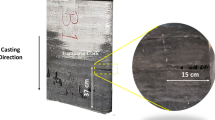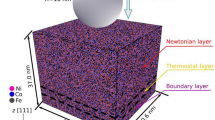Abstract
The fracture toughness of a high carbon TRIP alloy, deformed approximately 75 pct at 460°C was investigated over a range of temperatures from −196°C to 200°C. Two distinct temperature regimes were present: a low temperature regime where martensite formed during fracturing and a high temperature regime where no martensite formed. The toughness values of the low temperature regime were higher than the extrapolated values of the high temperature regime indicating that the transformation makes a positive contribution to the fracture toughness of TRIP alloys. For the alloys used in this investigation the room temperature plane strain fracture toughnessK IC was on the order of 95 ksi\(\sqrt {in} \) or in terms of the crack extension forceG IC, 274 in.-lb per sq in. The fracture mode was cleavage and the extraordinary toughness for this mode of crack extension is attributed to the energy absorbed by the simultaneous phase transformation. The contribution due to the phase transformation was determined to be in the range 37 to 57\(\sqrt {in} \) in terms of stress intensity or 168 to 232 in.-lb. per sq in. in terms of crack extension force using the extrapolation technique. The results obtained using the extrapolation technique represent the first experimental determination of the toughness contribution associated with the austenite to martensite phase transformation in TRIP alloys. An expression for the toughness associated with the transformation was derived using fundamental fracture mechanics relations. This expression, which contains easily measured parameters, was used to calculate the toughness contribution due to the phase transformation and the results were in good agreement with the experimental values.
Similar content being viewed by others
References
V. F. Zackay, E. R. Parker, D. Fahr and R. Busch:Trans. ASM, 1967, vol. 60, pp. 252–59.
Stephen D. Antolovich:Trans. TMS-AIME, 1968, vol. 242, pp. 2371–73.
Stephen D, Antolovich and D. Fahr: Paper presented at the Fourth National Fracture Mechanics Symposium, Pittsburgh, Pennsylvania, August 24–26, 1970.
W. W. Gerberich, P. L. Hemmings, V. F. Zackay, and E. R. Parker:Fracture 1969, pp. 288–305, Chapman and Hall Ltd., London, 1969.
W. W. Gerberich, P. L. Hemmings, M. D. Merz, and V. F. Zackay:Trans. ASM, 1968, vol. 61, pp. 843–847.
E. T. Wessel:Eng. Fracture Mech., 1968, vol. 1, pp. 77–103.
Book of ASTM Standards, 1970, Part 31, pp. 911–27.
Stephen D. Antolovich and Birindar Singh:Met Trans., 1970, vol. 1, pp. 3463–65.
W. F. Brown and John E. Srawley:Am. Soc. Testing Mater., Spec. Tech. Publ. 410, 1966, p. 25.
F. A. McClintock and G. R. Irwin:Am. Soc. Testing Mater., Spec. Tech. Publ. 381, 1965, pp. 84–113.
W. J. McGregor Tegart:Elements of Mechanical Metallurgy, MacMillan, 1966, p. 71.
Paul C. Paris and George C. Sih:Am. Soc. Testing Mater., Spec. Tech. Publ. 381, 1965, pp. 30–81.
Author information
Authors and Affiliations
Additional information
BIRINDAR SINGH, formerly Graduate Research Assistant, Department of Materials Science, University of Cincinnati
Rights and permissions
About this article
Cite this article
Antolovich, S.D., Singh, B. On the toughness increment associated with the austenite to martensite phase transformation in TRIP steels. Metall Trans 2, 2135–2141 (1971). https://doi.org/10.1007/BF02917542
Received:
Issue Date:
DOI: https://doi.org/10.1007/BF02917542




